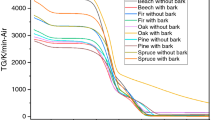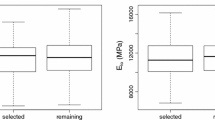Abstract
Burnt wood has been found to perform different from sound (green) wood when dried together, but also with regards to other physical and mechanical properties. In this study the drying performance of wood burnt to different degrees in recent plantation fires was investigated, and the physical, chemical and wood anatomical properties of these different wood types were determined. Different cell structure and chemical composition due to thermal degradation could be observed as well as different drying performance and variation in mechanical properties. An explanation for the deviant drying performance was attempted with the observed structural changes.
Zusammenfassung
Es wurde festgestellt, dass sich verbranntes Holz oft anders verhält als unbeschädigtes (frisches) Holz, wenn beide Holzarten zusammen getrocknet werden, aber auch in Hinsicht auf physikalische und mechanische Eigenschaften. In diesem Projekt wurde das Trocknungsverhalten von Holz mit unterschiedlich starkem Verbrennungsgrad untersucht und Unterschiede in physikalischen, chemischen und anatomischen Eigenschaften festgestellt. Ein Unterschied in der Zellstruktur und in der chemischen Zusammensetzung, hervorgerufen durch thermische Degradierung, konnte festgestellt werden; ebenso ein Unterschied im Trocknungsverhalten und eine Variation in den mechanischen Eigenschaften. Eine Erklärung für das unterschiedliche Trocknungsverhalten anhand der beobachteten strukturellen Änderungen wurde versucht.



Similar content being viewed by others
References
Ashton DH (1986) Viability of seeds of Eucalyptus oblique and Leptospermum juniperinum from capsules subjected to a crown fire. Austral For 49:28–35
ASTM Designation: D 4761-05 (2005) Standard test methods for mechanical properties of lumber and wood-base structural material. ASTM International, PA, USA
Bourgois J, Bartholin MC, Guyonnet R (1989) Thermal treatment of wood: analysis of the obtained product. Wood Sci Technol 23(4):303–310
Charrier B, Haluk JP, Metche M (1995) Characterization of European oakwood constitutes acting in the brown discolouration during kiln drying. Holzforschung 49:168–172
Cutter BE, Cumbie BG, McGinnes EA (1980) SEM and shrinkage analyses of southern pine wood following pyrolysis. Wood Sci Technol 14:115–130
Forestry South Africa (FSA) (2007) 6th Annual Report for the Year Ended 31st December 2007. pp 11–12. http://www.forestry.co.za/website_about_fsa_annual_reports/
Hill C (2006) Wood modification: chemical, thermal and other processes. John Wiley & Sons, West Sussex, England, pp 99–126
Kim DY, Nishiyama Y, Wada M, Kuga S, Okano T (2001) Thermal decomposition of cellulose crystallites in wood. Holzforschung 55:521–524
Koch G, Puls J, Bauch J (2003) Topochemical characterisation of phenolic extractives. Holzforschung 57:339–345
Lingens A, Windeisen E, Wegener G (2005) Investigating the combustion behaviour of various wood species via their fire gases. Wood Sci Technol 39:49–61
Manninen AM, Pasanen P, Holopainen JK (2002) Comparing the atmospheric emissions between air-dried and heat treated Scots Pine wood. Atmos Environ 36(11):1763–1768
McDonald AG, Fernandez M, Kreber B, Laytner F (2000) The chemical nature of kiln brown stain in radiata pine. Holzforschung 54(1):12–22
Nuopponen M, Vuorinen T, Jamsa S, Viitaniemi P (2003) The effects of a heat treatment on the behaviour of extractives in softwood studied by FTIR spectroscopic methods. Wood Sci Technol 37:109–115
Pandey KK, Theagarajan KS (1997) Analysis of wood surfaces and ground wood by DRIFT and PAS FTIR techniques. Holz Roh- Werkst 55:383–390
Rowell R (1984) The chemistry of solid wood, 1st edn. American Chemical Society, Washington, DC, USA, pp 229–446
Sandermann W, Augustin AH (1964) Chemical effects of heat on cellulose. Chem Rev 44:687–697
South African National Standard SANS 5984 (2004) Moisture content of timber and timber products (oven dry method)
South African National Standard SANS 1783-1 (2007) Sawn softwood timber, Part 1: General requirements
Whelan RJ (1995) The ecology of fire, 1st edn. Cambridge University Press, Cambridge, England
Williamson GB, Black EM (1981) High temperatures of forest fires under pines. Nature 293:643–644
ZA Dry Q (2004) Kiln Drying Management System. South African Lumber Driers Association (SALDEA), SALMA, Pretoria, South Africa
Acknowledgements
We thank Timbadola sawmill for the provision of green and burnt wood.
Author information
Authors and Affiliations
Corresponding author
Rights and permissions
About this article
Cite this article
Meincken, M., Smit, N.H. & Steinmann, D. Physical properties of burnt timber, with special focus on the drying performance. Eur. J. Wood Prod. 68, 455–461 (2010). https://doi.org/10.1007/s00107-009-0388-z
Received:
Published:
Issue Date:
DOI: https://doi.org/10.1007/s00107-009-0388-z




